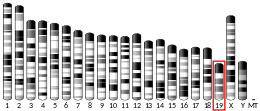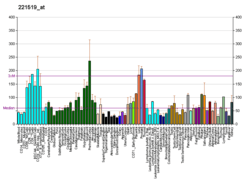FBXW4
F-box/WD repeat-containing protein 4 is a protein that in humans is encoded by the FBXW4 gene.[5][6][7]
This gene is a member of the F-box/WD-40 gene family, which recruit specific target proteins through their WD-40 protein-protein binding domains for ubiquitin mediated degradation. In mouse, a highly similar protein is thought to be responsible for maintaining the apical ectodermal ridge of developing limb buds; disruption of the mouse gene results in the absence of central digits, underdeveloped or absent metacarpal/metatarsal bones and syndactyly. This phenotype is remarkably similar to split hand-split foot malformation in humans, a clinically heterogeneous condition with a variety of modes of transmission. An autosomal recessive form has been mapped to the chromosomal region where this gene is located, and complex rearrangements involving duplications of this gene and others have been associated with the condition. A pseudogene of this locus has been mapped to one of the introns of the BCR gene on chromosome 22.[7]
References
- GRCh38: Ensembl release 89: ENSG00000107829 - Ensembl, May 2017
- GRCm38: Ensembl release 89: ENSMUSG00000040913 - Ensembl, May 2017
- "Human PubMed Reference:". National Center for Biotechnology Information, U.S. National Library of Medicine.
- "Mouse PubMed Reference:". National Center for Biotechnology Information, U.S. National Library of Medicine.
- Gurrieri F, Prinos P, Tackels D, Kilpatrick MW, Allanson J, Genuardi M, Vuckov A, Nanni L, Sangiorgi E, Garofalo G, Nunes ME, Neri G, Schwartz C, Tsipouras P (Oct 1996). "A split hand-split foot (SHFM3) gene is located at 10q24-->25". Am J Med Genet. 62 (4): 427–36. doi:10.1002/(SICI)1096-8628(19960424)62:4<427::AID-AJMG16>3.0.CO;2-Q. PMID 8723077.
- Palmer SE, Scherer SW, Kukolich M, Wijsman EM, Tsui LC, Stephens K, Evans JP (Jul 1994). "Evidence for locus heterogeneity in human autosomal dominant split hand/split foot malformation". Am J Hum Genet. 55 (1): 21–6. PMC 1918225. PMID 7912888.
- "Entrez Gene: FBXW4 F-box and WD repeat domain containing 4".
Further reading
- Ianakiev P, Kilpatrick MW, Dealy C, et al. (1999). "A novel human gene encoding an F-box/WD40 containing protein maps in the SHFM3 critical region on 10q24". Biochem. Biophys. Res. Commun. 261 (1): 64–70. doi:10.1006/bbrc.1999.0963. PMID 10405324.
- Ilyin GP, Rialland M, Pigeon C, Guguen-Guillouzo C (2001). "cDNA cloning and expression analysis of new members of the mammalian F-box protein family". Genomics. 67 (1): 40–7. doi:10.1006/geno.2000.6211. PMID 10945468.
- Strausberg RL, Feingold EA, Grouse LH, et al. (2003). "Generation and initial analysis of more than 15,000 full-length human and mouse cDNA sequences". Proc. Natl. Acad. Sci. U.S.A. 99 (26): 16899–903. doi:10.1073/pnas.242603899. PMC 139241. PMID 12477932.
- de Mollerat XJ, Gurrieri F, Morgan CT, et al. (2004). "A genomic rearrangement resulting in a tandem duplication is associated with split hand-split foot malformation 3 (SHFM3) at 10q24". Hum. Mol. Genet. 12 (16): 1959–71. doi:10.1093/hmg/ddg212. PMID 12913067.
- Basel D, DePaepe A, Kilpatrick MW, Tsipouras P (2004). "Split hand foot malformation is associated with a reduced level of Dactylin gene expression". Clin. Genet. 64 (4): 350–4. doi:10.1034/j.1399-0004.2003.00153.x. PMID 12974740.
- Busino L, Donzelli M, Chiesa M, et al. (2003). "Degradation of Cdc25A by beta-TrCP during S phase and in response to DNA damage". Nature. 426 (6962): 87–91. doi:10.1038/nature02082. PMID 14603323.
- Roscioli T, Taylor PJ, Bohlken A, et al. (2004). "The 10q24-linked split hand/split foot syndrome (SHFM3): narrowing of the critical region and confirmation of the clinical phenotype". Am. J. Med. Genet. A. 124 (2): 136–41. doi:10.1002/ajmg.a.20348. PMID 14699611.
- Ota T, Suzuki Y, Nishikawa T, et al. (2004). "Complete sequencing and characterization of 21,243 full-length human cDNAs". Nat. Genet. 36 (1): 40–5. doi:10.1038/ng1285. PMID 14702039.
- Deloukas P, Earthrowl ME, Grafham DV, et al. (2004). "The DNA sequence and comparative analysis of human chromosome 10". Nature. 429 (6990): 375–81. doi:10.1038/nature02462. PMID 15164054.
- Kang YS, Cheong HM, Moon Y, et al. (2004). "Molecular genetic characterization of a Korean split hand/split foot malformation (SHFM)". Mol. Cells. 17 (3): 397–403. PMID 15232212.
- Gerhard DS, Wagner L, Feingold EA, et al. (2004). "The status, quality, and expansion of the NIH full-length cDNA project: the Mammalian Gene Collection (MGC)". Genome Res. 14 (10B): 2121–7. doi:10.1101/gr.2596504. PMC 528928. PMID 15489334.
- Kano H, Kurosawa K, Horii E, et al. (2006). "Genomic rearrangement at 10q24 in non-syndromic split-hand/split-foot malformation". Hum. Genet. 118 (3–4): 477–83. doi:10.1007/s00439-005-0074-0. PMID 16235095.
- Everman DB, Morgan CT, Lyle R, et al. (2006). "Frequency of genomic rearrangements involving the SHFM3 locus at chromosome 10q24 in syndromic and non-syndromic split-hand/foot malformation". Am. J. Med. Genet. A. 140 (13): 1375–83. doi:10.1002/ajmg.a.31246. PMID 16761290.




